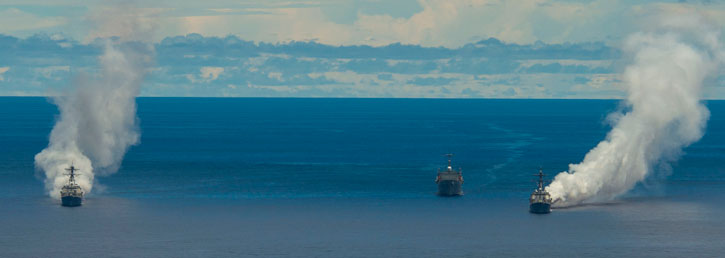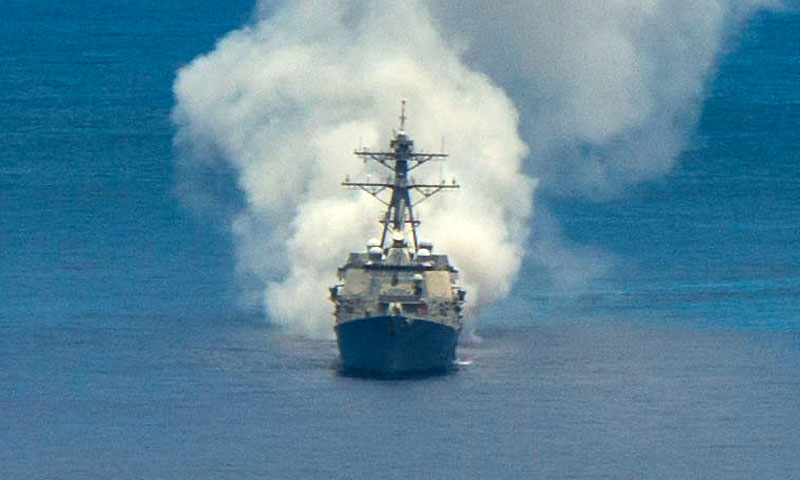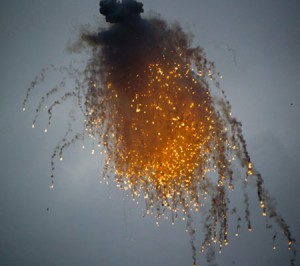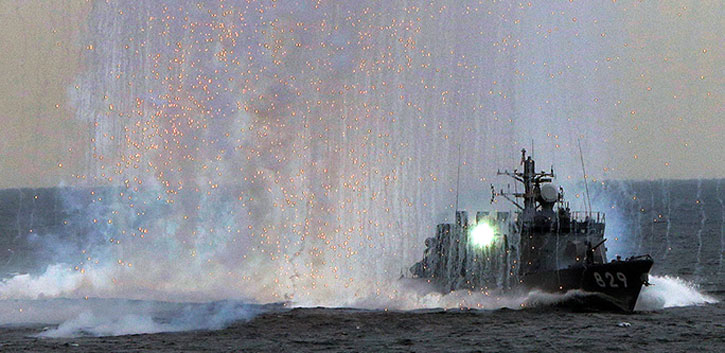 |
| During the ‘Pandarra Fog’ evaluation, the systems and tactics were tested under a variety of at-sea conditions using Seventh Fleet units and assets from the U.S. Army, Navy, and Air Force to evaluate how radar-absorbing, carbon-fiber clouds can prevent a missile from detecting and striking its target as part of a layered defense. Photo: US Navy, by Timothy Wilson. |
 |
| USS
Mustin (DDG 89), USS Wayne E. Meyer (DDG 108) and USS Frank Cable (AS
40) test maritime obscurants held south of Guam to assess their tactical
effectiveness for anti-ship missile defense. Note how the distribution
of the cloud can be manipulated by the ship, under the same wind
conditions, while the vessels maintain the same heading. (U.S. Navy
photo, Timothy Wilson) |
The US Navy has recently tested a new anti-ship missile countermeasure system using an obscurant generator prototype. The systems and tactics were tested under a variety of at-sea conditions using assets from the U.S. Army, Navy, and Air Force to evaluate how radar-absorbing, carbon-fiber clouds can prevent a missile from detecting and striking its target as part of a layered defense.
The Naval Warfare Development Command tested the maritime obscurant generator prototypes June 21-25 to assess their tactical effectiveness for anti-ship missile defense. The shipboard device generates carbon-fiber particles suspended in a cloud of smoke. These particles absorb and diffuse radar waves emanating from the seekers of incoming missiles, thus potentially obscuring the target from the missile’s seeker.
 |
| During
the ‘Pandarra Fog’ evaluation, the systems and tactics were tested
under a variety of at-sea conditions using Seventh Fleet units and
assets from the U.S. Army, Navy, and Air Force to evaluate how
radar-absorbing, carbon-fiber clouds can prevent a missile from
detecting and striking its target as part of a layered defense. Photo:
US Navy, by Timothy Wilson. |
“Pandarra Fog showed the value of quickly bringing together
scientific and joint forces to tackle our hardest warfighting problems.
This isn’t just smoke or chaff, this is high tech obscurant, which can
be effective against an array of missile homing systems,” said Antonio
Siordia, U.S. Seventh Fleet’s science adviser.
Vice Adm. Robert L. Thomas Jr., commander U.S. Seventh Fleet, kicked
off the “Pandarra Fog”, the multi-ship experiment in Guam. “Pandarra Fog
is example of the quick-turn integrated technical and tactical
development the Fleet is doing to master electromagnetic maneuver
warfare and assure access of joint forces,” Thomas said.
The experiment demonstrated maritime obscurant generation can be a
key enabler of offensive manoeuvre of the fleet despite the global
proliferation of anti-ship cruise and ballistic missiles.
Thoughtful obscurant employment will significantly reduce the risk to surface ships from missile strikes
“We are developing a layered approach using a full spectrum of active
and passive capabilities to give us the advantage. It is not just about
the technology, but also practicing how the fleet will employ these
emerging capabilities,” said Capt. David Adams, who leads the Seventh
Fleet Warfighting Initiatives Group. “A defense in depth approach has a
lot of advantages. Not only do we know the smoke is effective, it adds a
level of uncertainty and unpredictability to the equation,” said Adams.
 |
| Smoke
screening is part of a multi-layered defense of surface vessels, which
also includes active defense (air defense missiles), active decoys
(jammers and RF decoys) chaff. The flares (seen in this photo) may be
used for a last ditch defense, luring thermal seekers off target. |
In addition to having a significant level of effectiveness, the systems are relatively inexpensive when compared to other countermeasures and can be tactically employed through typical fleet maneuvers. The materials are environmentally friendly and sized to maximize operational effectiveness. “Our initial assessment is the testing was very successful in terms of tactical employment, usability and cost-effectiveness,” said Adams. defense-update.
 |
| The Japanese patrol boat Shiritaka (PG 829) fires a screen of flares on a
naval display. On an operational deployment the flares create a screen
of hot obscurant that can hide the vessel from incoming heat-seeking
missiles. |






Post a Comment Blogger Facebook Disqus